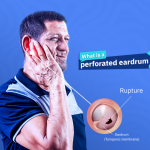Ear Cancer
Ear cancer is one of the rare malignant tumors that can develop abnormally in any part of the ear—whether the outer, middle, or inner ear. It tends to spread quickly, starting locally and extending to the eardrum or auditory canal.
In this article, you’ll discover everything you need to know about Ear Cancer in detail.
- Types of Ear Cancer
- Causes of Ear Cancer
- Symptoms of Ear Cancer
- How Ear Cancer is Diagnosed
- Treatment Options for Ear Cancer
Types of Ear Cancer:
Ear cancer is classified into two main types:
External Ear Cancer: Occurs in the skin of the outer ear.
- Middle and Inner Ear Cancer: Affects the tissues located in the middle or inner ear.
Causes of Ear Cancer:
There are no definitive causes known to lead directly to Ear Cancer, but certain risk factors may increase the likelihood of developing it, including:
Aging
Recurrent ear infections
Continuous exposure to chemical substances
Prolonged exposure to harmful UV rays without adequate sun protection
- Genetics and family history of cancer—regular check-ups with an ENT specialist are crucial for prevention in such cases
Symptoms of Ear Cancer:
Initially, Ear Cancer may not present any noticeable symptoms. However, general signs that may suggest a tumor in the ear include:
Ear pain
Hearing loss
Discharge or pus from the ear
Tinnitus (ringing in the ear)
Dizziness
Symptoms may differ depending on the part of the ear affected, as explained below:
External Ear Cancer:
Affects the ear lobe and the entrance to the auditory canal. Symptoms include:
Red, scaly patches on the ear that do not heal with moisturizers
Bleeding sores
- Small white lumps under the skin
Auditory Canal Cancer:
Symptoms include:
Hearing loss
Discharge from the ear
Lumps forming at or near the entrance of the ear canal
Middle Ear Cancer:
Signs of tumors in this area include:
Hearing impairment
Persistent ear pain
Frequent bloody discharge
- A sensation of heaviness or numbness in the affected part of the ear
Inner Ear Cancer:
This type manifests through the following symptoms:
Ear pain
Tinnitus
Watery discharge from the ear
Dizziness
Persistent headaches
Difficulty in moving the facial muscles on the affected side
How Ear Cancer is Diagnosed:
To properly diagnose Ear Cancer and determine the appropriate treatment, the process usually involves several stages:
Reviewing any family history of cancer
Collecting detailed information about the patient’s symptoms
Conducting a thorough internal and external ear examination
If abnormalities are observed, a biopsy may be taken from ear tissue for lab testing
- Using X-rays or MRI to examine the internal structure of the ear
Treatment Options for Ear Cancer:
The appropriate treatment is determined based on two main factors:
The size of the cancerous mass
The exact location of the cancer
There are three primary treatment options, selected according to the above considerations:
Surgical Removal: Extracting the cancer cells entirely
Radiation Therapy: Targeting and destroying cancer cells
Chemotherapy
The choice of treatment depends on the ENT specialist’s diagnosis and the patient’s input. The goal is to relieve the patient’s pain, eliminate cancer cells, and take preventive measures to avoid recurrence.
Ultimately, treatment outcomes depend on the type, location, and severity of the tumor. Some patients may require hearing aids due to hearing impairment caused by Ear Cancer. It is crucial to emphasize that early detection is key to successful treatment. The more proactive the approach, the better the outcomes.






